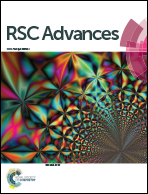Synthesis of pure nickel(iii) oxide nanoparticles at room temperature for Cr(vi) ion removal†
Abstract
Ni2O3 nanoparticles of various sizes (∼25.8 to 49.7 nm), obtained by a facile oxidation process using Ni(NO3)2·6H2O, NaOH and sodium hypochlorite as precursor materials at various temperatures (0°, 25°, 50° and 70 °C), are found to remove toxic Cr(VI) from aqueous solution (20 g L−1). The structure, morphology, surface charge and chemical compositions of the synthesized samples were characterized by XRD, TEM, zeta potential and EDX respectively. Adsorption capacity is found to be strongly dependent on the size and surface heterogeneity of the synthesized particles and a plausible mechanism for such significant adsorption efficacy is attributed to the sorbate–sorbent electrostatic interaction and shielding of Cr(VI) ions. The adsorption mechanism fits with the Langmuir isotherm model with maximum 60% Cr(VI) removal capacity (20.768 mg g−1 (calculated) and 20.408 mg g−1 (predicted from isotherms)) corresponding to Ni2O3 nanoparticles, prepared at 70 °C in 3 hours at room temperature. Thermodynamic parameters, obtained from fitting, demonstrate that the adsorption process being endothermic in nature follows a pseudo-second-order kinetic model. The spontaneity of the adsorption process gets reduced with increasing particle size. pH of the solution is observed to have a remarkable effect on the adsorption, giving maximum adsorption at pH = 6.


 Please wait while we load your content...
Please wait while we load your content...